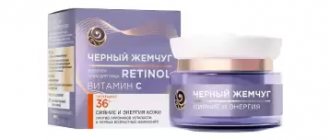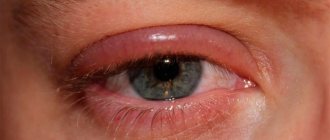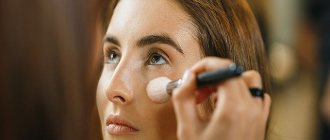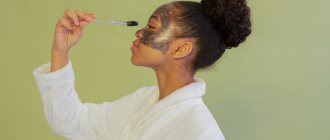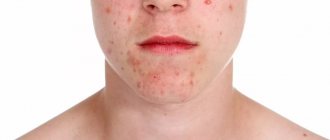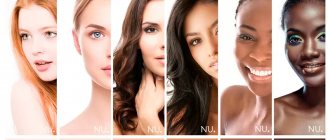Do you like yourself more in black and white photographs than in color ones, because monochrome hides an uneven and dull complexion?
You can restore the radiance to your face with your own hands.
We revive and even out the color in just a couple of weeks. From the outside, we polish the skin, “cleaning off” all excess, dead, gray. From the inside, we help the blood nourish the dermis: we achieve the structure of healthy and radiant skin, as it was in our youth.
Read what we are fighting and how.
What does complexion say?
How much in the perception of a woman’s image is determined by the color of her face! If our skin tone is sallow, we look tired and aged. And also uneven coloring - can this happen to a young and blooming woman? All those dark circles under the eyes, spider veins, age spots? Of course not.
As you know, complexion is one of the indicators of human health. . Red skin is a sign of fever, heart and vascular diseases. The face becomes yellow when something is wrong with the liver, spleen, or stomach. Blue means there are breathing problems. White is evidence of anemia, stroke, heart attack, and lung pathologies. Darkened skin may indicate kidney disease or bladder infection. An earthy gray hue hints at constipation and other gastrointestinal problems.
But there is such an expression as “blood and milk”. Who are they talking about? About women whose faces are healthy, even in color, with a slight blush on their cheekbones. They are not white, not gray, not red, not blue, not yellow - all these shades are not about youth and health.
In general, we are programmed by nature to perceive a changed complexion as a sign of ill health. And health is an integral ingredient of attractiveness.
But, as a rule, the complexion deteriorates not due to any pathologies. In most cases, everything is to blame for our incorrect lifestyle and bad habits. That is, we ourselves do everything in order to look tired, sick, and old.
They ask you, “Did something happen?”, “Are you sick?”, “Didn’t get enough sleep?”, but everything is the same with you, nothing special. You just live without thinking about the fact that you need to change something to make your skin glow again.
Of course, age decides a lot. It takes away our natural resources, which made our skin look young and blooming. But still more depends on ourselves. Only we ourselves are able to control when age-related changes will occur and how intense they will be.
First, let's figure out what processes in the skin lead to deterioration of color, and then let's see what factors aggravate these negative changes.
Blue face
The blue color accompanies life-threatening heart or lung diseases, or covers the face when taking certain medications.
Blue face as a result of treatment
A drug such as Cordarone can turn the face blue. In this case, you need to consult a cardiologist about reducing the dosage of the medication.
The second cause of ceruloderm (as doctors call blue skin) is the use of silver preparations, mainly for antiseptic purposes, for example, for a runny nose. People involved in silver processing also get sick. This condition is called argyria and usually leads to damage to the bone marrow, eyes, kidney failure and damage to the nervous system - silver salts accumulate not only in the skin, but also in all internal organs, vessel walls, mucous membranes, sclera of the eyes, and remain there for the entire life.
If a person stops using medications containing silver salts, the symptoms of damage to internal organs will go away, but the blue color of the skin will remain.
Methemoglobinemia
This is the name of the condition when normal hemoglobin is replaced by an altered one - methemoglobin, in which iron is not divalent, but trivalent, and cannot carry oxygen. This disease most often appears during poisoning with hemolytic poisons. For example, it occurs with an overdose of Paracetamol, the use of long-stored Phenacetin and sulfonamides, as well as in cases where large amounts of nitrates and nitrites are ingested in food (they are found in well and tap water, in canned meat, in fruits fertilized with nitrate-nitrite fertilizers and vegetables). There are also hereditary forms of pathology.
For any form of the disease, the symptoms will be as follows:
- the skin acquires a gray-blue tint;
- the nail phalanges do not change their shape (if the heart or lungs are affected, the nail-bearing phalanges expand, taking on the appearance of “drum sticks”);
- physical activity is accompanied by shortness of breath and fatigue;
- headaches are frequent and severe.
Cardiopulmonary diseases
These pathologies cause both generalized cyanosis, when the whole body acquires a bluish tint, and regional cyanosis, manifested by blueness of the skin under the nails, the tip of the nose, lips and nasolabial triangle.
This condition develops in various diseases:
- Heart failure . In this case, there is pain in the heart during physical activity, shortness of breath at rest, which increases with physical activity, and swelling, localized mainly in the legs. An ECG or ultrasound of the heart can determine the disease that caused this pathology.
- Asthma attack . Here, the appearance of an attack can be associated with an encounter with an allergen (for example, plant pollen or household chemicals), there is a dry cough, it becomes difficult to exhale, and sometimes wheezing can be heard from afar.
- Pneumonia . It is not always, but often manifested by cough and fever. In addition, there is shortness of breath, a feeling of lack of air, weakness, and nausea.
- Cyanotic variant of erythrocytosis.
- Tuberculosis . In this case, a cough is noted: it is dry, sometimes during a cough attack a certain amount of mucous sputum is released. The temperature rises to low levels (up to 38 degrees), weakness and increased fatigue are noted.
- Pulmonary embolism: when one or more branches of the vessel leading from the heart to the lungs develops a “congestion” or blockage with a blood clot, fat, gas, or masses detached from the inflamed heart valves. The disease develops abruptly: often after straining or performing heavy physical work, a person with varicose veins, heart defects or an aneurysm suddenly develops weakness, shortness of breath with a feeling of lack of air. A little later, a cough and pain in one of the halves of the chest develop.
- Any type of shock , manifested by a sharp decrease in blood pressure. Shock can develop with significant dehydration, large amounts of bacteria entering the body, blood loss, severe pain due to injury, or anaphylaxis.
- Heart defects . Often, only fatigue is subjectively felt; there may be rhythm disturbances and headaches. The upper half of the body may differ in color from the lower.
- Chronic bronchitis . It manifests itself as a cough, fever, and sometimes a feeling of shortness of breath. If a person has had this disease for a long time, his fingers change: the nail phalanges thicken, becoming like “drumsticks.” Nails also change: they become dull, they are covered with grooves (such nails are called “watch glasses”).
- Pleurisy . This condition develops after pneumonia. It is characterized not only by the development of a bluish coloration of the skin, but also by a repeated increase in body temperature that has already returned to normal, chest pain when breathing, chills, weakness, and night sweats.
- Pneumothorax . This term characterizes a condition when, due to injury to the lung, air penetrates into the cavity surrounding it. If the amount of air increases, then it compresses the lung itself and the heart lying nearby. Is it dangerous. The pathology develops acutely, usually after physical effort or a coughing fit. Severe pain appears on the side of the damaged lung, which intensifies with deep inspiration, coughing and movement. Shortness of breath and a feeling of lack of air also appears.
How skin becomes dull: mechanisms
Let's break down the problem of dull and uneven complexion.
- Let's start with the fact that in the epidermis there are special cells that are responsible for color - melanocytes
. They produce the pigment melanin. It is he who determines the color of the skin (hair, by the way, too). Different races have this pigment in different concentrations; albinos do not have it at all. Our tan also depends on melanin. When we are in the sun, melanin absorbs ultraviolet rays, thereby protecting the deep layers of the skin from photodamage and the integument darkens.Over the years, the level of melanocytes and their activity decreases. According to scientific research, after 30 years, the number of these cells decreases by 10-20% every decade. The main external enemy that damages these cells is the sun.
- Also, the color of the skin is harmed by any unevenness on it: accumulated dead epidermal cells, peeling, acne, scars. What's the connection? A smooth surface reflects light better. If it is embossed, then the rays are scattered, and the skin appears dull.
- Skin looks gray if it is dehydrated. What is responsible for moisture saturation? Hyaluronic acid in the dermis (it attracts and holds water molecules) and the hydro-lipid mantle that covers the epidermis. Accordingly, if the activity of hyaluronic acid is reduced and the water-fat layer becomes thinner, this leads to a loss of healthy color.
- Do not forget about the nature of the location of superficial blood vessels - the color of the skin also depends on them. When the skin becomes thinner, the capillaries become visible and dark circles appear under the eyes. And the vessels themselves change over the years: they expand, become fragile, brittle. Externally, this manifests itself in the formation of spider veins.
Pharmacy drugs
Gray complexion (the causes for women are individual and require diagnosis) in some cases can be corrected with the help of medications, ointments, and vitamins.
Calcium chloride
If the cause of the gray color is a violation of the surface layer of the skin, then this can be corrected with the help of calcium chloride. To do this, soft peeling is carried out with a solution of calcium chloride. A rich cream is applied to the cleansed face, and then the face is wiped with a cotton pad moistened with a 5% calcium chloride solution.
After absorbing the liquid, calcium should be applied to the face a second time. After 3–5 minutes. the liquid is applied a third time. Then the baby soap is foamed and rubbed in a circular motion onto the skin.
The result is a scrub on the face, which is washed off with chamomile infusion. As a result of the combination of calcium chloride and alkali, salts of higher carboxylic acids were formed, which helped restore complexion.
Panthenol ointment
Regenerating drug, 9% Panthenol, has a complex effect on the skin, activates cells, restores microcirculation. The cream can be used daily and also applied under cosmetics. The ointment, as an additional source of pantothenic acid and fats, is well suited for dry, discolored skin.
Ointment Radevit
The drug is indicated for use for external use on irritated skin with increased sensitivity, for the purpose of prevention against aging. It is applied twice a day in a thin layer. The duration of therapy depends on the condition of the skin.
Cream Vitamin “F99”
Dermatotropic product based on linoleic acid and ethyl esters. The ointment is available in two categories: bold and semi-bold. Apply a small layer to the face twice a day.
Thiogamma 600
A drug that regulates lipid and carbohydrate metabolism. Tablets are taken orally, 1 piece. (600 mg) per day.
The course of treatment is from 1 to 2 months. The active substance contained in the drug helps reduce glucose levels and increases the concentration of glycogen in the liver.
Causes of dull complexion
There are many external factors that lead to a dull and uneven complexion. If they are neglected, the problem of color deterioration can occur even in young and healthy women.
What are we talking about?
- Ultraviolet irradiation.
The sun and solarium are the main causes of premature skin aging. If you do not protect yourself from ultraviolet radiation, the skin will acquire a gray tint and uneven color (hyperpigmentation, dyschromia, rosacea). - Lack of water.
If you don't drink enough clean water, your skin will become dry and dull. Capillary blood circulation, which should give the skin a healthy color, will be disrupted. - Insufficient exfoliation.
The accumulation of dead skin cells creates an uneven texture and makes it difficult to nourish the skin. - Incorrect cosmetic care.
Poor cleansing of the skin is a prerequisite for the appearance of clogged pores, rashes, and dullness. And, conversely, abuse of this procedure will lead to disruption of the integrity of the protective layer and to dehydration. Cosmetics also provide hydration and protection from aggressive external factors - these stages of care should also not be neglected. - Bad habits.
Cigarettes and alcohol poison the body with toxins and have a destructive effect on the skin of the face. The result is dull color, dryness, loss of tone and elasticity. - Wrong lifestyle.
The complexion is harmed by inactivity, lack of sleep, nervous exhaustion, and stress. - Eating disorder.
You can’t: eat toxic foods, starve, undereat, overeat. Necessary: eat only healthy foods, balanced in the content of nutrients, vitamins and minerals.
Pallor
Pale or unhealthy white color indicates various diseases, in which:
a) there is acute or chronic blood loss:
- endometriosis;
- ectopic pregnancy;
- peptic ulcer;
- internal bleeding;
b) the blood vessels of the skin spasmed so that there was enough blood for the central organs:
- angina pectoris;
- oncological diseases of any localization;
- heart defects;
- aortic aneurysm;
- fat embolism;
c) diseases that occur with intoxication, due to which vasospasm occurs: ARVI (especially influenza), asthma attack, tuberculosis and other infectious diseases;
d) there is not enough melanin, which causes the skin to become more “transparent”. If this occurs throughout the skin, and there is also a lack of melanin in the iris of the eye, then this is albinism or phenylketonuria. When individual white spots appear on the skin, we can talk about vitiligo, a disease that has many causes;
e) deficiency of substances from which hemoglobin is formed: iron, folic acid, vitamin B12, proteins, glutathione, glucose-6-phosphate dehydrogenase. These are different types of anemia - deficiency and hypoplastic. The latter may occur due to kidney disease;
f) autonomic regulation of blood vessels is impaired (vegetative-vascular dystonia). This can be said if the pale color occurs during stress, fear, or nervous experiences;
g) hormonal regulation of vascular tone is disrupted: diabetes mellitus, hypothyroidism;
h) edema, due to which skin vessels are poorly visible: hypothyroidism, kidney disease, loss of proteins due to exudative enteropathy, burns, malabsorption syndrome.
Prevention to maintain a healthy complexion
Have you not yet experienced the problem of dull color and want to maintain a healthy and even complexion?
Follow a few rules:
- Protect yourself from the sun.
Creams with UV filters, sunglasses, wide-brimmed hats, caps, long sleeves, abstaining from direct sun exposure from 11:00 to 17:00... Everything your skin needs to prevent its photoaging has already been invented. Use these tools. Only a neat and even tan suits your face. You are not a dried fruit to dry in the sun all day. - Drink clean water.
Minimum 2 liters per day. - Eat right.
No food waste, only healthy foods, and in sufficient quantities. Read more about what you can and cannot eat in a separate chapter below. - Move more.
Walk, run, ride a bike, play sports. - Give up bad habits.
Cigarettes - in the trash, alcohol - occasionally and little by little. - Get enough sleep.
Let your body and skin recover. If you don't get enough sleep chronically, your body will begin to become exhausted, your skin will become dull, and your face will look tired and painful. - Take proper care of your skin using cosmetics.
Cleansing and moisturizing your skin twice a day is an essential foundation for a healthy complexion. If your skin is dry, dehydrated, aged, also nourish it with additional products: creams, oils, serums, squalane, balms, masks. - Limit the use of decorative cosmetics.
Your cosmetic bag no longer holds all these endless products for an even tone and beautiful highlights: primers, concealers, correctors, BB and CC creams, foundations, powders, blushes, highlighters, bronzers? You don't think that all this multi-layered beauty is harmless? This is an attack on the skin that leads to clogged pores and, paradoxically, dull complexion. Know when to stop, give your face a break from aggressive makeup. - Learn self-massage and facial exercises.
This is the best way to prolong the youth of your face and maintain an even, healthy color. Start working on your face at 20-25 years old 2-3 times a week. After 30 years, the procedure is mandatory for every woman. If you are not satisfied with your complexion, classes should be daily, the course should be 3 weeks. A verified set of rejuvenating techniques for the face is contained in the basic marathon “SmeloNET” from MelAnnett.
Let’s take a closer look at the main rules for maintaining a healthy complexion.
Vitamins
The skin always needs vitamins. Deficiency affects the development of negative processes, the skin becomes dull, discolored, and irritated.
Vitamin supplements essential for skin:
| Name | Features of application |
| Hemafemin | Increases estrogen production, restores the immune system, improves complexion, and improves skin elasticity. |
| Vitrum beauty | The drug is a multivitamin, contains amino acids, improves skin structure, normalizes metabolism. |
| Perfectile | Eliminates dry skin, restores radiance to the skin, and maintains skin tone. |
| Imedin | Actively cares for the skin, moisturizes, improves skin color and structure, and is a source of vitamin C and zinc. |
| Laura collagen drink | The dietary supplement Solgar restores water balance, tightens the skin, and improves color. |
It is very difficult to get all the vitamins in everyday life. You can’t get around without additional complexes. They are necessary for the body, skin, and hair.
How does water affect skin color?
The skin consists of 70% water, and its supporting layer - the dermis - is 90%. If there is not enough water in the body, then the skin is the first to react. It becomes dull and dry, its relief changes, and its turgor decreases. The face takes on a stale, tired appearance and is covered with fine wrinkles.
Moreover, the position of the skin is vulnerable. It is from this that the body takes moisture first if it experiences a lack of fluid.
Where does our skin get moisture from?
There are two channels: internal (drinking) and external (skin absorbs water from the air like a sponge). But the first one is the main one. The covers are saturated with moisture mainly from the inside, and not from the outside.
The skin absorbs moisture from the atmosphere only when the air humidity is high - 55% or more. And if this threshold is maintained outdoors for most of the year, then indoors everything is much worse. When the batteries are turned on, the air becomes too dry, and the reverse process begins: moisture evaporates from the skin.
If you've been to Egypt and Thailand, then you know how differently your skin feels in a dry desert and in a humid Asian climate.
The problem of dry air can be controlled using a humidifier. But the main thing that needs to be monitored is the uninterrupted operation of the main channel through which liquid enters the body: drinking.
Start your day with a glass of clean water and drink at least 2 liters of it throughout the day. It is believed that the body needs at least 30 ml of water per 1 kg of weight.
About skin
Human skin is the organ with the largest area. On average, it occupies 2 square meters in an adult, and its total mass is more than 10 kilograms. The main task of the skin, present from birth: to protect the underlying tissues from the penetration of microbes and chemicals into them. In addition, it protects them from high and low temperatures, ultraviolet and other rays, for which the subcutaneous tissue and muscles are clearly not designed. The skin also performs other very important functions: it participates in respiration, thermoregulation, synthesizes some vitamins, enzymes and bioactive substances, and conveys information about pain, tactile sensations and temperature to the spinal cord. It can absorb substances applied to it, delivering them into the systemic circulation.
From 3-4 months of life, another important function of the integumentary tissue, which is relevant to our topic, develops - excretory. The skin removes some of the products, both those formed during the normal functioning of organs, and those that arise during the neutralization of toxins by our main “filters”.
A person's complexion depends on:
- combinations of pigments in it;
- thickness of the stratum corneum;
- the depth of the location of vessels in it and their filling;
- on the intensity of metabolism occurring in the body.
Changing each of the parameters leads to a change in complexion. Let's look at all this in more detail.
Proper nutrition
To keep your facial skin fresh and glowing, it is important to follow the rules of a healthy diet.
- Avoid food waste.
Stop eating everything that clogs your body with toxins and poisons it. If you see foods and trans fats on the label, put the product back on the shelf. Not allowed: sausages, semi-finished products, canned food, confectionery, chips, crackers, snacks, hamburgers, French fries. Keep sugar to a minimum.Forget about fast food forever. Now the “fastest food” in your diet is fresh vegetables and fruits.
- Eat a balanced diet.
Your body should receive all the substances it needs in sufficient quantities: proteins, fats, carbohydrates, fiber, vitamins, minerals.- Make sure your diet contains proteins, calcium, phosphorus: red meat, legumes, fish, greens, etc.
Eat at least 4-5 servings of vegetables and fruits.
- Give preference to complex carbohydrates: buckwheat, oats, brown rice, whole grain flour products.
- Of the fats, the body needs monounsaturated (avocados, olives) and polyunsaturated (fatty fish, algae, nuts, sunflower, flaxseed oil).
- Follow your daily caloric intake.
For women of normal build this is, on average, 2 thousand kcal. If you want to lose weight, then cut your calories slightly, by 10-15%, and get the rest through physical activity and training.
Physical activity is an important part of life
If you run a search on the Internet, you will notice that over the past 20 years, many diseases have moved from old ones, corresponding to advanced age, into the category of young ones. Why is this happening? Usually, there is one answer to all the troubles associated with diseases: bad ecology. But what about lifestyle, doesn’t it affect the color of our faces?
Or is being surrounded by screens around the clock – a TV, a computer, a smartphone or a tablet – nothing to do with it?
Staying around the clock in front of flickering monitors - at home or in the workplace - is not good for your facial skin.
It dries out from constant heating and operation of system unit fans and printer cooling systems, loses moisture, and becomes flabby.
And the answer to the question of why the sallow complexion appeared so unexpectedly, the reasons must be sought in the same lifestyle, deprived of the necessary physical activity.
Rejection of bad habits
Do you have a good idea of what happens to the complexion of smokers and alcoholics?
In alcoholics, it becomes sallow gray and uneven. The cheeks, wings of the nose, and chin are covered with a rosacea mesh.
In smokers, the skin also loses its natural color and acquires gray, yellowish, pale shades. There is even such a term as “smoker’s face”: in addition to altered color, it also refers to emaciated features, atrophic skin, and deep wrinkles.
But this can be fixed. If you quit smoking and stop drinking too much alcohol, your skin will begin to transform right before your eyes. Within two weeks, your complexion will improve.
Jaundice
Diseases in which a yellow complexion is observed have a common name - jaundice. This color is sometimes given by carotene if a person has eaten too many carrots. In this case, only the palms and soles are painted. In other cases, yellowness occurs when too much bilirubin is formed - a product that is formed from hemoglobin in red blood cells and then metabolized in the liver. A lot of bilirubin is produced either when a lot of red blood cells break down, or when liver function is disrupted.
Red blood cells disintegrate either due to the weakness of their own membrane, or when a substance enters the blood (for example, anti-Rh antibodies or poisons) that destroys the blood cells. Conditions caused by membrane disruption have a common name - hemolytic jaundice. There are many types of them, which only a hematologist can distinguish. Poisoning with hemolytic poisons is dealt with by toxicologists who have an artificial kidney apparatus in their arsenal. When red blood cells are destroyed due to burns, treatment takes place in the Combustiology Departments.
There is another type of jaundice - caused by diseases of the liver and biliary tract:
- blockage of the bile ducts by tumors, stones or inflammation;
- Gilbert's syndrome;
- hepatitis: viral, toxic (including medicinal), alcoholic;
- cirrhosis of the liver.
Jaundice will also manifest itself as inflammation of the pancreas, directly connected to the liver and gall bladder.
Bilirubin is a dangerous substance that can destroy the brain. Therefore, if yellowing of the skin appears, you should urgently call an ambulance. On his own, a person can only drink “Activated carbon” or another sorbent drug. It is also important to tell doctors what you ate or drank. In this case, the person’s future health depends on the urgency of the assistance provided by toxicologists.
Good dream
Your skin needs proper rest to recover. This is an elementary rule, but in the modern world it is often violated.
Try to improve your sleep schedule.
- Go to bed at 10 pm.
- Sleep at least 8 hours.
- Take care of the microclimate of the room. If the air is dry, turn on a humidifier at night.
Makeup removal
Cleansing the skin is the basis for a healthy complexion.
The face needs to be cleansed twice a day: morning and evening. Even if you don’t use cosmetics, dust, dirt, and oil accumulate on your skin and need to be removed.
And if makeup also comes into play, the harmful load on the skin increases. Overuse of makeup and poor cleansing lead to clogged pores, rashes, and dull color.
Going to bed with makeup not washed off is like putting your face in a trash can and walking around without washing off the dirt.
What you need to know about cleansing? It should be gentle and not dry out the skin. Instead of washing with tap water and special products (gels, creams, foams), try a more modern option - hydrolates.
Have you heard anything about them?
Hydrolates are obtained by steam distillation of plant materials. They contain nothing but clean water and plants. They retain the benefits of natural ingredients while effectively cleansing the face. The skin after them is soft and moisturized.
To cleanse your face with hydrate you do not need water. Morning and evening, wipe your skin with a cotton pad, after moistening it in the product. Throughout the day, tone and moisturize your skin as needed.
Excellent hydrolates are presented in the Beauty365 line. Go to www.beauty365.ru and choose Beauty365 mint, sage or lavender hydrosol based on your skin type.
Gray face
Gray color is described in the following conditions:
- Leukemia . These pathologies are very insidious, masquerading as ARVI: weakness, drowsiness appear, and body temperature rises. Most often they are detected when a general blood test is prescribed.
- Diseases of the digestive system : pancreatitis, cholecystitis. In this case, nausea, bloating, bowel movements, pain in the upper abdomen when eating spicy, smoked or fatty foods, or alcohol are noted.
- Smoking and stress.
- After suffering serious illnesses.
Regular use of scrubs
Another necessary part of facial care is exfoliation. By clearing the skin of dead scales, we help it breathe and regenerate. We also create the effect of a polished surface, thanks to which the sun’s rays are better reflected and the skin glows.
Anti-aging care must necessarily include exfoliating procedures. They need to be done 1-3 times a week. As a rule, women use scrubs, but a more effective option is available at home - drybrushing (massage with a dry brush).
A dry brush polishes the skin until it squeaks. There will not be a single dead cell left on the face that interferes with normal light reflection. In addition, there is a deep effect on the tissue: spasming muscles relax, blood flow and lymphatic drainage increase, and collagen production in the skin is stimulated. All this is needed to rejuvenate the face and return it to a healthy, even color.
We recommend choosing a dry brush with natural bristles for your face. Go to www.beauty365.ru and look for the Beauty365 dry face brush, which is made from boar bristles.
Perform a massage with a brush on dry and clean skin. Follow the massage lines (see the tip on the Beauty365 facial brush packaging).
After the procedure, the skin will shed all excess and warm up - the perfect moment to nourish it with your favorite cream or oil. Pay attention to Beauty365 natural cosmetics: squalane, oils, balms (sold at www.beauty365.ru).
Prefer green tea to black
Green tea has anti-inflammatory properties and soothes Green tea in dermatology – myths and facts the skin - reduces the amount of irritation, thereby evening out its color. Bonus: This drink contains antioxidants that slow down aging and wrinkles.
Drink iced 11 Steps to better skin tea. Hot drinks can cause redness of the skin.
Andrea Cambio
dermatologist
For the effects of green tea to be fully realized, you should drink at least a couple of cups a day.
How to improve your complexion at home
Do you have a dull complexion?
Do you want to improve your complexion and skin condition?
Are you wondering if you can restore your skin color quickly at home?
Firstly, we have already given most of the answers to these questions when we talked about preventing facial dullness. All these measures are necessary to restore color. Follow the general recommendations regarding:
- healthy and active lifestyle,
- proper nutrition and drinking regime,
- skin care through exercise and cosmetics.
Additionally, try a few more ways to improve your complexion.
Earthy color
If your face suddenly acquires an unhealthy, sallow color, this may indicate chronic lack of sleep, lack of fresh air, unbalanced diet, excessive tanning and smoking. But most often this shade indicates pathology. For example:
- Poor functioning of the thyroid gland . At the same time, the face becomes not only dull, but also puffy. The skin is dry, and the hair is brittle, splits and falls out. There is also excess weight with decreased appetite and poor nutrition.
- Oncological disease (cancer) of any localization, including leukemia.
- HIV infections . At the same time, the disease is staged: at first, a slightly elevated temperature lasts for several months, then it increases and a large number of lymph nodes begin to be felt. Only then does the color of the skin fade, a person begins to often suffer from pneumonia, every small violation of the integrity of the skin takes a long time to heal, and long-term diseases develop, the cause of which cannot be immediately found.
- Sepsis (blood poisoning). In this case, at first there are symptoms of some bacterial disease: inflammation of the kidneys, lungs, festering wound, abscess, osteomyelitis, sinusitis, and so on. Then, after a short-term improvement, the temperature rises again, weakness, headache and nausea appear. This is complemented by symptoms of kidney or liver damage.
Even complexion, folk remedies and masks to even out complexion
- Apricot mask
Pulp of 2 apricots + 1 tbsp. l. milk + 1 tsp. liquid honey.All ingredients must be warm. Grind, mix, apply to face for 20 minutes (except for the area around the eyes) and rinse with warm water.
Acids, vitamins B and C, zinc and selenium in the composition will help your skin shine again.
- Parsley mask
1 tbsp. l. finely chopped parsley + 1 tsp. sea buckthorn oil + 1 quail egg yolkMix to a paste, apply to face for 10 minutes (except for the area around the eyes) and rinse with water.
Parsley whitens, mattifies and rejuvenates the skin. Be sure to try this mask if you have age spots.
- Carrot mask
1 finely grated carrots + 1 tsp. oatmeal + half an yolk + a few drops of lemon juice.Leave the mixture on your face for 15-20 minutes and wash off with cool water.
There are still a lot of recipes for natural cosmetics that can be easily prepared from simple ingredients. Cucumber, lemon, oatmeal, coffee, bananas, berries - many ingredients that are found in every kitchen are used. You can, for example, simply wipe your face with cucumbers. Try different recipes and find what will help even out and improve your complexion.
Also, to even out the color, pay attention to folk peeling recipes. For example, try using coffee grounds or ground oatmeal as scrubbing elements.
Beauty365 camellia sasanqua oil perfectly whitens the skin and prevents the appearance of seasonal freckles (it can be purchased at www.beauty365.ru).
Diagnostics
A therapist will tell you how to determine what causes a change in complexion. When prescribing your tests or recommending a consultation with a more specialized specialist, he will proceed from the new shade of your skin.
So, if your face is pale, you will be prescribed:
- general blood test with mandatory determination of reticulocytes - the ancestors of red blood cells;
- osmotic resistance of erythrocytes;
- coagulogram;
- liver tests.
If you are concerned about yellowness, the therapist refers you to an infectious disease specialist, and he, focusing on the history of your life and this disease, as well as ultrasound of the liver, gallbladder and pancreas, liver tests and markers for viral hepatitis, decides whether he, a gastroenterologist or hematologist.
Olive complexion requires the attention of a gastroenterologist, who will examine, palpate and listen to your stomach, prescribe an ultrasound of the abdominal cavity (it is performed after preparation) and FEGDS (here you will have to swallow the probe).
Black or blue shades that appear overnight, especially if there is a feeling of lack of air, require calling an ambulance. These specialists will figure out who should consult or treat you. If black spots are bothering you, but there are no other symptoms, it is advisable to consult the staff of the Department of Dermatology.
Cardiologists will help determine the reasons for the red color. These doctors will come to the aid of a tonometer for measuring blood pressure and an ECG. They will probably also need an ultrasound of your kidneys and adrenal glands to find out the cause of your high blood pressure, as well as an ultrasound of your heart.
Using blush and highlighters
As an express method, you can do corrective makeup. This way you can quickly achieve an even color and add tint and radiance to your skin.
Highlights can be achieved using a highlighter. Apply it to the convex parts of the face: cheekbones, the bridge of the nose, the area above and below the eyebrow, chin, the hollow above the upper lip and the depression under the lower lip. Apply the product carefully using a brush or ring finger.
Blush will help imitate a natural blush. Start by smiling broadly. Do you see the apples of the cheeks? Apply blush on them. If your face is wide, bring the color along your cheekbones up to the hairline. You only need a little product, and blend it thoroughly so as not to look like a matryoshka doll.
But remember that any makeup needs to be thoroughly cleaned before going to bed. And a complete “combo” (concealer + foundation + powder + highlighter + blush + etc.) is not suitable for daily use. Give your skin a break from decorative cosmetics.
Redness of the skin
A red complexion is not always a sign of alcohol abuse, as previously thought. This is a sign of the following diseases:
- Arterial hypertension (increased blood pressure), which can accompany hypertension, develops as a result of kidney or adrenal diseases. Redness of the face develops against the background of a headache, spots before the eyes, and pain in the heart.
- Carbon monoxide poisoning . This happens to people with stove heating who are in an unventilated room.
- Erythrocytosis , in which there is too much hemoglobin and red blood cells, which does not improve oxygen transport, but poses a danger in terms of increased thrombus formation. Here the face and shoulders are bright red. This intensifies after taking a bath, and with this comes skin itching.
- Allergic reaction : to medications, food, household chemicals, introduction of worms into the intestines and other things. In addition to redness, a dry cough, sneezing, and possibly diarrhea often appear. Improvement is observed if the allergen is eliminated.
- Rosacea . At first, the skin turns red only when exposed to heat or cold, but gradually the face ceases to return to its normal color. Typically, pathology develops in women during menopause. It must be distinguished from the redness of the face characteristic of this period, which accompanies the sensation of “flushing”.
- Tuberculosis . Here the cheeks are constantly red, but this color is not bright. In addition, the nasolabial triangle has a bluish tint, there is also a cough, and a constantly elevated temperature; the person sweats heavily.
- Scarlet fever : the face turns red and the nasolabial triangle becomes pale. In addition, the temperature rises, and a red rash spreads throughout the body.
- Pneumonia , when one cheek turns red. There is also a feeling of difficulty breathing, cough, weakness, and increased body temperature.
- Sinusitis . Here one cheek is also painted - on the affected side. At the same time, there is a headache, a fever, a stuffy nose, and when instilled, a large amount of secretion is released, often mucopurulent.
- Both cheeks and the back of the nose turn red with a disease such as systemic lupus erythematosus.
- Redness of the cheeks against the background of an intestinal infection or acute respiratory infection in a child is a sign that his underlying disease has been complicated by the development of acetonemic syndrome. This is a condition when the body uses fats rather than glucose as energy substrates, the breakdown products of which have a toxic effect on the brain.
- A large dose of atropine or scopolamine for a given person.
- Poisoning with hallucinogens.
Also, the face - especially if a person suffers from vegetative-vascular dystonia - changes its color to red with any illness that is accompanied by an increase in temperature.
How to refresh your complexion at a cosmetologist
And a few more words about whether it is possible to improve your complexion with a cosmetologist. There are offers on the market, but how effective and safe are they? Let's figure it out.
Cosmetologists, as a rule, offer to work with complexion using various hardware techniques. Their task is to stimulate skin renewal. Most often this is:
- laser peeling,
- ultrasonic cleaning,
- microcurrents (pulsed electric current, supplied in portions with interruptions),
- galvanic currents (direct electric current).
You may also be invited to the salon for a massage, chemical peeling or injections (the most radical method).
First things first.
What can you say about peeling? Of course, it is needed for a healthy color. Remember how the accumulation of dead skin cells on the skin affects light reflection and color? But all salon types of peeling (laser, ultrasound, acids) work aggressively, peel off the upper layers of the skin almost to the flesh, and are often associated with burns. Choose softer, but no less effective options. You already know about the main thing - drybrushing (massage with a dry brush).
It is more difficult to assess the effect of currents on the face. On the one hand, currents act on muscles to restore their tone. The idea itself is good. And technically, electrical stimulation can both tense and relax muscles (there are different attachments for this). But the problem is that many cosmetologists position this procedure as a way to train muscles, rather than relax them. Currents are understood as a way to force muscles to contract.
Do our facial muscles need this? They have already worked all their lives and are already in hypertonicity from overexertion, and then there is artificial stress. It will only worsen age-related changes.
It is important to understand the difference between the face and body. The muscles of the body need strength loads, but the face does not. Imagine the situation: a girl is too lazy to squat, and she pumped up her butt with the help of currents. Of course, physical training is more effective and allows you to maintain lasting results, while electrical stimulation only gives a temporary effect. Sooner or later, a girl will have to understand that she needs to get her elastic butt off the couch and start working out so that it doesn’t sag. But in principle, the procedure was understandable and, most likely, harmless.
But currents on the face are another matter. If a cosmetologist offers you to “train your facial muscles” using electrical stimulation, remember that your face is not your butt. In order for the facial muscles to be in healthy tone, they need to be relaxed and spasms relieved.
The most aggressive salon method offered to improve complexion is injections:
- biorevitalization (a drug based on hyaluronic acid is administered),
- mesotherapy (mesococtail, a drug with a complex composition),
- plasmophiling (patient's blood plasma).
All this harms the skin. The techniques are based on multiple facial injections. Hundreds of injections are given in one session, and many sessions are needed. Due to such total trauma, the face becomes covered with pathological fibrous compactions, and this is definitely not a story about a healthy color.
The safest salon method for restoring complexion is massage. But it’s better to do it yourself.
biorevitalization (a drug based on hyaluronic acid is administered),
mesotherapy (mesococtail, a drug with a complex composition),
Darkening of color
This word can describe complexion in various diseases.
Adrenal insufficiency
A uniformly dark complexion, when the skin can be described as bronze or too dark, is characteristic of adrenal insufficiency - usually primary, when the paired endocrine organ itself suffers. In this case, it will not be the face that will darken at first, but not the parts of the body protected by clothing, those that rub against parts of clothing and those that are already pigmented (peripapillary circle, genitals, armpits). In addition, there will be weight loss, digestive disorders, and sometimes changes in the sexual sphere. Learn more about the symptoms and causes of adrenal insufficiency.
Thyrotoxicosis
When the dark color does not cover the face evenly, but with blurred brown spots, this indicates increased activity of the thyroid gland. Additional signs that speak in its favor will be a rapid, palpable heartbeat, skin that is hot to the touch, irritability, increased appetite and, at the same time, weight loss.
Spots with hyperthyroidism must be distinguished from lentigo or chloasma - areas of melanin accumulation that occur due to other reasons. In both of these cases, there will be no changes in the general condition - only areas of darker skin will appear. And they, unlike spots with hyperthyroidism, will not change their shape and color. Read more about the symptoms and treatment of thyrotoxicosis.
Liver pathologies
If not the entire face darkens, but only the area near the hair, this indicates liver disease. In this case, a person may notice a deterioration in appetite, a desire to sleep longer, an aversion to fatty foods and bleeding when brushing teeth, or heavier periods. If there is at least one more sign, in addition to areas of darkening of the face, contact a therapist or gastroenterologist and take a liver test. Read more about the symptoms of liver disease.
Bacterial endocarditis
The word “dark color” can also describe light brown, which is also called “coffee with milk”. This is the complexion characteristic of prolonged septic endocarditis, a disease in which bacteria settle on the heart valves, leading to the development of polyposis and ulcers here.
This pathology is characterized by a slow deterioration of the condition in a person who has long been diagnosed with valvular heart disease. He begins to get tired faster and wants to lie down more often. Unpleasant sensations or minor pain appear in the heart. The same vague and unexpressed pains are noted in the joints.
Body temperature rises: usually to low levels, with chills and palpitations. Later it rises to 39 degrees, chills appear, and the person sweats profusely. Sometimes the temperature immediately rises to high levels, an attack of heart palpitations develops, and first one thing or another hurts. In some cases, the temperature remains elevated for a long time to 37.8, and against this background it periodically rises to 39 and above.
Septic endocarditis is a life-threatening disease: masses of endocardium “recycled” by bacteria, which were located here in the form of polyps, “fly off” from the valves. Such emboli can clog the vessels of organs: brain, kidneys, spleen, limbs, skin. Kidney damage is manifested by darkening of the urine, the appearance of blood in it, and a decrease in its amount. With cerebral embolism, clouding of consciousness, dizziness, double vision, muscle twitching or convulsions occur. A sudden loss of consciousness with difficulty breathing may occur, which leads to death if help is not provided urgently.
Hemorrhages occur in the skin, which look like large or smaller areas soaked in blood (irregular bruises), the center of which is whitish. They do not rise above the skin, and often affect only the skin of the legs and the conjunctiva of the lower eyelid. The disease is also characterized by the following symptom: the appearance of red, dense and painful nodules on the palms or soles, which resolve after 2-3 days.
Hemochromatosis
Here, grayish-brown or dark brown spots appear on the skin, merging with each other, which can serve as a reason for making a preliminary diagnosis of chronic adrenal insufficiency. An accurate diagnosis is made by skin biopsy in stained areas, when deposits of hemosiderin and melanin are detected.
Early systemic scleroderma
Here, numbness and coldness of the hands first appear, accompanied by the feeling of crawling “goosebumps”. These symptoms bother the patient for several years without being supplemented by anything else. Then dark spots appear on the hands, face and feet, or only in a separate location. They are dense, seem to consist of thick skin, spread to free areas, and hinder movements of the facial muscles. The diagnosis is made by detecting antibodies to RNA polymerase, topoisomerase I or histone in the blood (one type of antibody is detected in each patient), as well as antinuclear factor (it is detected in 90-95%).
Porphyria cutanea tarda
When this disease develops after exposure to the sun, as well as when drinking alcohol, blisters appear on exposed areas of the body, the skin becomes brittle and brittle, darkens, but may also lighten. After the slightest injury to the skin, the same thing happens. The conjunctiva of the eyes swells and turns red, while the throat does not turn red, and no other cold symptoms occur. Ultrasound shows liver damage.
Variegated porphyria manifests itself in a similar way. Only doctors distinguish them.
Recklinghausen's neurofibromatosis
In this case, a brown spot of varying diameter (café au lait color) appears on the body - one or many. The disease debuts in childhood. It is also characterized by premature puberty and high blood pressure.
Similar symptoms are characteristic of two other diseases that appear in childhood - Watson's syndrome and Albright's syndrome. Only doctors can distinguish them.
Dysplastic nevus syndrome
Dark brown spots with a clear border appear on the skin. Papules raised above the skin and variegated in color may also develop. There are usually no other complaints.
Leopard syndrome
Dark brown spots are found everywhere on the skin. And although other symptoms are not subjectively disturbing, when performing an ECG, various types of changes are noted. An ultrasound of the heart reveals a decrease in the lumen (stenosis) of the pulmonary artery.
Peutz-Jeghers syndrome
Multiple dark brown spots appear on the lips and fingers. In addition, periodic pain in the abdomen (closer to the navel) is bothersome. When examined by a gastroenterologist or during an X-ray examination of the intestine with preliminary administration of contrast (barium), polyposis of the small intestine is detected.
Natural rejuvenation: self-massage and exercises
Having mastered simple self-massage techniques, you can help your face every day and maintain the results for years. In addition, you don’t have to pay yourself for the procedure, you don’t have to endure inconvenience, travel somewhere, waste time, or rearrange your schedule.
You will find the best techniques for self-massage of the face in the basic marathon “SmeloNET” from MelAnnett. The course also includes exercises on posture, stretching the neck, and restoring mobility to the aponeurosis of the head. All this is necessary so that blood flows freely to your face, nourishes the skin, gives it radiance and an even color.
Read the details about the basic marathon “SmeloNET”, look at the photos of the participants and register!
When a tan does not decorate, but only harms the skin
Tanning has the ability to highlight the beauty of the skin and hide its imperfections. But this is possible with a light tan.
Long stay in the sun or frequent stay in the solarium harms the well-being of the skin: it deprives the skin of the necessary reserves of moisture, and its elasticity is lost.
As a result, the skin takes on a tired, dull appearance. It becomes a grayish, sickly color. Pigments appear that add several extra years to the appearance.
Against the background of an overabundance of sunbathing, problems may begin not only with the appearance, but also with the internal state. There is a possibility of developing problems with the kidneys and lymph system due to their disruption by excess tanning.
It is important to know! Be careful in the sun or tanning beds. Don't forget to apply protective cream. Hide your skin under natural fabrics as much as possible.
Skin covered, for example, with linen fabric feels much more comfortable than being under the open sun. This will keep your face from turning sallow instead of golden tan.
